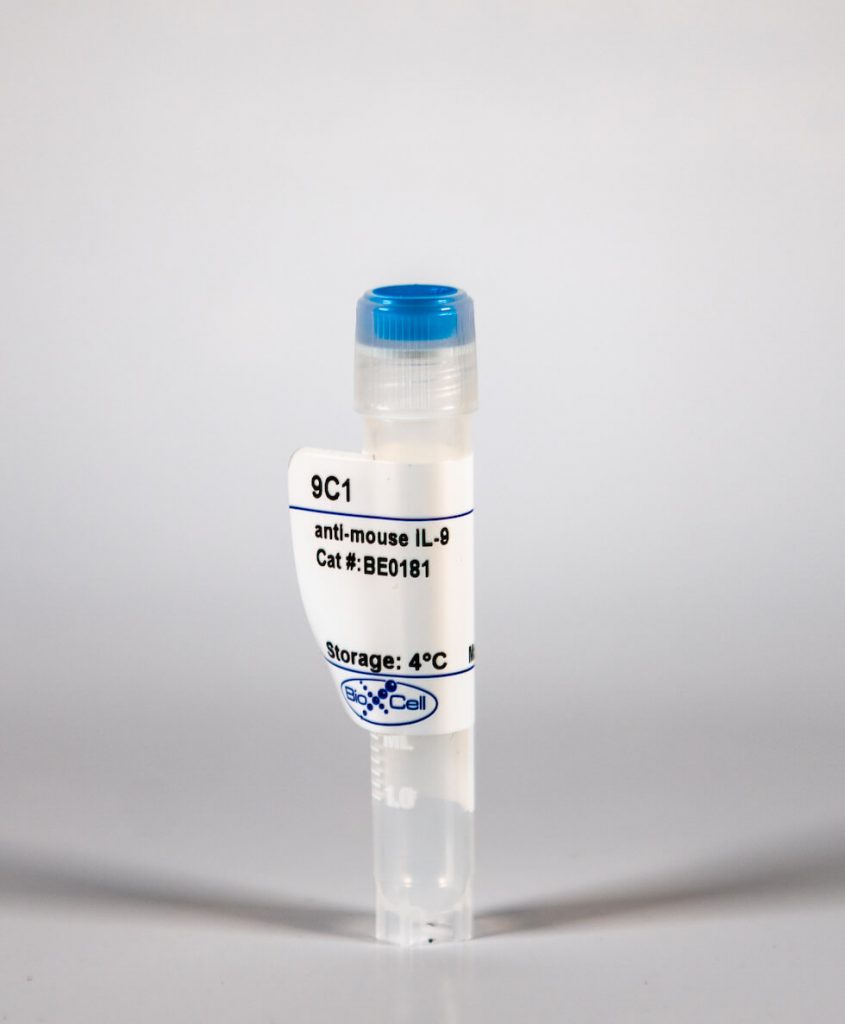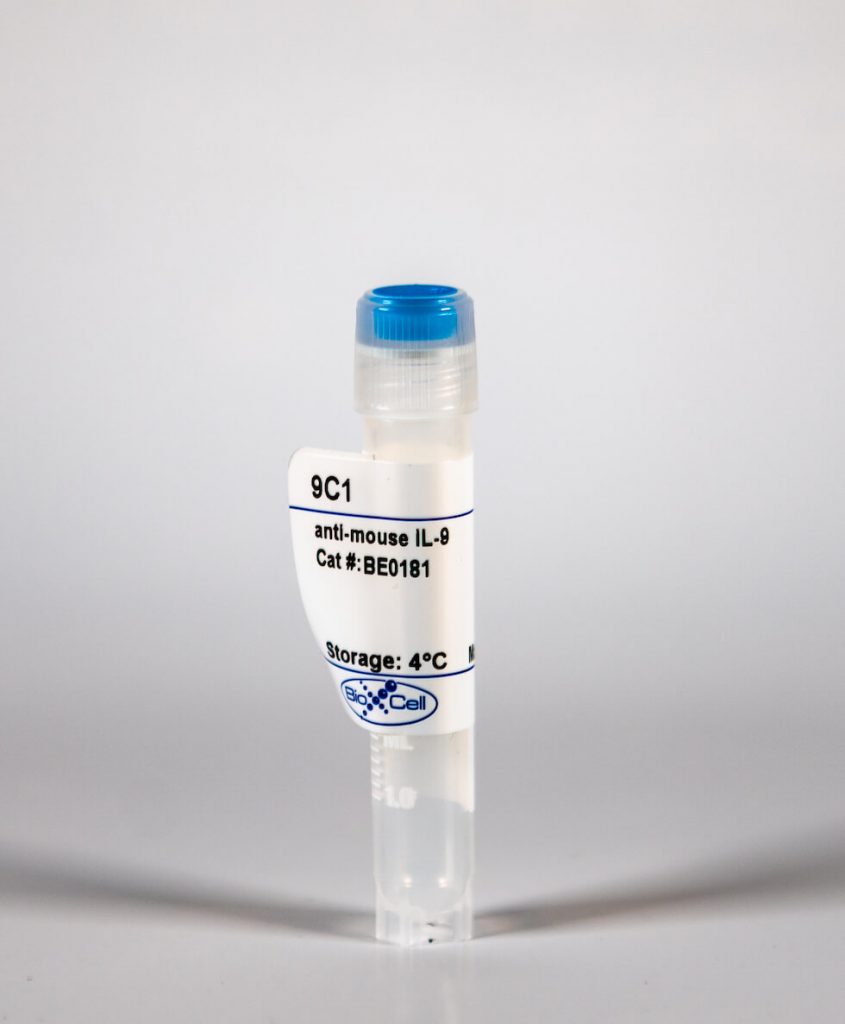InVivoMab anti-mouse IL-9
| Clone | 9C1 | ||||||||||||
|---|---|---|---|---|---|---|---|---|---|---|---|---|---|
| Catalog # | BE0181 | ||||||||||||
| Category | InVivoMab Antibodies | ||||||||||||
| Price |
|
The 9C1 monoclonal antibody reacts with mouse IL-9, a pleiotropic cytokine expressed by Th9 cells, Th2 cells, Th17 cells, regulatory T cells, NKT cells, ILC2s, and mast cells. IL-9 promotes mast cell and T cell proliferation, stimulates mast cell accumulation in tissues, promotes ILC survival, enhances class-switching to IgE in B cells and alters haematopoietic progenitor cell activity. Additionally, IL-9 enhances mucus production from airway epithelial cells and alters barrier function in the intestines. IL-9 is thought to contribute to asthma. The 9C1 antibody has been reported to block the bioactivity of IL-9.'
| Isotype | Mouse IgG2a |
| Recommended Isotype Control(s) | InVivoMAb mouse IgG2a isotype control, unknown specificity(BE0085) |
| Recommended InVivoPure Dilution Buffer | InVivoPure pH 7.0 Dilution Buffer(IP0070) |
| Immunogen | Mouse IL-9-OVA complex |
| Reported Applications | in vivo IL-9 neutralization |
| Endotoxin |
|
| Purity |
|
| Formulation |
|
| Sterility | 0.2 μM filtered |
| Production | Purified from tissue culture supernatant in an animal free facility |
| Purification | Protein G |
| Storage | The antibody solution should be stored at the stock concentration at 4°C. Do not freeze. |
| RRID | AB_10950648 |
| Molecular Weight | 150 kDa |
InVivoMAb anti-mouse IL-9 (Clone: 9C1)
Monteiro, M., et al. (2015). "IL-9 Expression by Invariant NKT Cells Is Not Imprinted during Thymic Development." J Immunol 195(7): 3463-3471. PubMed
Invariant NKT (iNKT) cell thymic development can lead to distinct committed effector lineages, namely NKT1, NKT2, and NKT17. However, following identification of IL-9-producing iNKT cells involved in mucosal inflammation, their development remains unaddressed. In this study, we report that although thymic iNKT cells from naive mice do not express IL-9, iNKT cell activation in the presence of TGF-beta and IL-4 induces IL-9 secretion in murine and human iNKT cells. Acquisition of IL-9 production was observed in different iNKT subsets defined by CD4, NK1.1, and neuropilin-1, indicating that distinct functional subpopulations are receptive to IL-9 polarization. Transcription factor expression kinetics suggest that regulatory mechanisms of IL-9 expression are shared by iNKT and CD4 T cells, with Irf4 and Batf deficiency deeply affecting IL-9 production. Importantly, adoptive transfer of an enriched IL-9(+) iNKT cell population leads to exacerbated allergic inflammation in the airways upon intranasal immunization with house dust mite, confirming the ability of IL-9-producing iNKT cells to mediate proinflammatory effects in vivo, as previously reported. Taken together, our data show that peripheral iNKT cells retain the capacity of shaping their function in response to environmental cues, namely TGF-beta and IL-4, adopting an IL-9-producing NKT cell phenotype able to mediate proinflammatory effects in vivo, namely granulocyte and mast cell recruitment to the lungs.
Nakatsukasa, H., et al. (2015). "The DNA-binding inhibitor Id3 regulates IL-9 production in CD4(+) T cells." Nat Immunol 16(10): 1077-1084. PubMed
The molecular mechanisms by which signaling via transforming growth factor-beta (TGF-beta) and interleukin 4 (IL-4) control the differentiation of CD4(+) IL-9-producing helper T cells (TH9 cells) remain incompletely understood. We found here that the DNA-binding inhibitor Id3 regulated TH9 differentiation, as deletion of Id3 increased IL-9 production from CD4(+) T cells. Mechanistically, TGF-beta1 and IL-4 downregulated Id3 expression, and this process required the kinase TAK1. A reduction in Id3 expression enhanced binding of the transcription factors E2A and GATA-3 to the Il9 promoter region, which promoted Il9 transcription. Notably, Id3-mediated control of TH9 differentiation regulated anti-tumor immunity in an experimental melanoma-bearing model in vivo and also in human CD4(+) T cells in vitro. Thus, our study reveals a previously unrecognized TAK1-Id3-E2A-GATA-3 pathway that regulates TH9 differentiation.
Nelson, M. H., et al. (2015). "The inducible costimulator augments Tc17 cell responses to self and tumor tissue." J Immunol 194(4): 1737-1747. PubMed
The inducible costimulator (ICOS) plays a key role in the development of Th17 cells, but its role in the development and antitumor activity of IL-17-producing CD8(+) T cells (Tc17) remains unknown. We found that ICOS costimulation was important for the functional maintenance, but not differentiation, of Tc17 cells in vitro. Blocking the ICOS pathway using an antagonist mAb or by using recipient mice genetically deficient in the ICOS ligand reduced the antitumor activity of adoptively transferred Tc17 cells. Conversely, activating Tc17 cells with an ICOS agonist in vitro enhanced their capacity to eradicate melanoma and induce autoimmune vitiligo when infused into mice. However, ICOS stimulation did not augment the antitumor activity of IL-2 expanded T cells. Additional investigation revealed that ICOS stimulation not only increased IL-2Ralpha, CXCR3, and IL-23R expression on Tc17 cells, but also dampened their expression of suppressive molecule CD39. Although Tc17 cells activated with an ICOS agonist cosecreted heightened IL-17A, IL-9, and IFN-gamma, their therapeutic effectiveness was critically dependent on IFN-gamma production. Depletion of IL-17A and IL-9 had little impact on antitumor Tc17 cells activated with an ICOS agonist. Collectively, our work reveals that the ICOS pathway potentiates the antitumor activity of adoptively transferred Tc17 cells. This work has major implications for the design of vaccine, Ab and cell-based therapies for autoimmunity, infectious disease, and cancer.
Xiao, X., et al. (2015). "GITR subverts Foxp3(+) Tregs to boost Th9 immunity through regulation of histone acetylation." Nat Commun 6: 8266. PubMed
Glucocorticoid-induced TNFR-related protein (GITR) is a costimulatory molecule with diverse effects on effector T cells and regulatory T cells (Tregs), but the underlying mechanism remains poorly defined. Here we demonstrate that GITR ligation subverts the induction of Foxp3(+) Tregs and directs the activated CD4(+) T cells to Th9 cells. Such GITR-mediated iTreg to Th9 induction enhances anti-tumour immunity in vivo. Mechanistically, GITR upregulates the NF-kappaB family member p50, which recruits histone deacetylases to the Foxp3 locus to produce a 'closed' chromatin structure. Furthermore, GITR ligation also activates STAT6, and STAT6 renders Il9 locus accessible via recruitment of histone acetyltransferase p300, and together with inhibition of Foxp3, GITR induces strong Th9 responses. Thus, Th9 cells and iTregs are developmentally linked and GITR can subvert tolerogenic conditions to boost Th9 immunity.
Gerlach, K., et al. (2014). "TH9 cells that express the transcription factor PU.1 drive T cell-mediated colitis via IL-9 receptor signaling in intestinal epithelial cells." Nat Immunol 15(7): 676-686. PubMed
The molecular checkpoints that drive inflammatory bowel diseases are incompletely understood. Here we found more T cells expressing the transcription factor PU.1 and interleukin 9 (IL-9) in patients with ulcerative colitis. In an animal model, citrine reporter mice had more IL-9-expressing mucosal T cells in experimental oxazolone-induced colitis. IL-9 deficiency suppressed acute and chronic colitis. Mice with PU.1 deficiency in T cells were protected from colitis, whereas treatment with antibody to IL-9 suppressed colitis. Functionally, IL-9 impaired intestinal barrier function and prevented mucosal wound healing in vivo. Thus, our findings suggest that the TH9 subset of helper T cells serves an important role in driving ulcerative colitis by regulating intestinal epithelial cells and that TH9 cells represent a likely target for the treatment of chronic intestinal inflammation.
Vegran, F., et al. (2014). "The transcription factor IRF1 dictates the IL-21-dependent anticancer functions of TH9 cells." Nat Immunol 15(8): 758-766. PubMed
The TH9 subset of helper T cells was initially shown to contribute to the induction of autoimmune and allergic diseases, but subsequent evidence has suggested that these cells also exert antitumor activities. However, the molecular events that account for their effector properties are elusive. Here we found that the transcription factor IRF1 enhanced the effector function of TH9 cells and dictated their anticancer properties. Under TH9-skewing conditions, interleukin 1beta (IL-1beta) induced phosphorylation of the transcription factor STAT1 and subsequent expression of IRF1, which bound to the promoters of Il9 and Il21 and enhanced secretion of the cytokines IL-9 and IL-21 from TH9 cells. Furthermore, IL-1beta-induced TH9 cells exerted potent anticancer functions in an IRF1- and IL-21-dependent manner. Our findings thus identify IRF1 as a target for controlling the function of TH9 cells.
Licona-Limon, P., et al. (2013). "Th9 Cells Drive Host Immunity against Gastrointestinal Worm Infection." Immunity 39(4): 744-757. PubMed
Type 2 inflammatory cytokines, including interleukin-4 (IL-4), IL-5, IL-9, and IL-13, drive the characteristic features of immunity against parasitic worms and allergens. Whether IL-9 serves an essential role in the initiation of host-protective responses is controversial, and the importance of IL-9- versus IL-4-producing CD4(+) effector T cells in type 2 immunity is incompletely defined. Herein, we generated IL-9-deficient and IL-9-fluorescent reporter mice that demonstrated an essential role for this cytokine in the early type 2 immunity against Nippostrongylus brasiliensis. Whereas T helper 9 (Th9) cells and type 2 innate lymphoid cells (ILC2s) were major sources of infection-induced IL-9 production, the adoptive transfer of Th9 cells, but not Th2 cells, caused rapid worm expulsion, marked basophilia, and increased mast cell numbers in Rag2-deficient hosts. Taken together, our data show a critical and nonredundant role for Th9 cells and IL-9 in host-protective type 2 immunity against parasitic worm infection.
Elyaman, W., et al. (2012). "Notch receptors and Smad3 signaling cooperate in the induction of interleukin-9-producing T cells." Immunity 36(4): 623-634. PubMed
Interleukin 9 (IL-9) is a pleiotropic cytokine that can regulate autoimmune responses by enhancing regulatory CD4(+)FoxP3(+) T regulatory (Treg) cell survival and T helper 17 (Th17) cell proliferation. Here, we analyzed the costimulatory requirements for the induction of Th9 cells, and demonstrated that Notch pathway cooperated with TGF-beta signaling to induce IL-9. Conditional ablation of Notch1 and Notch2 receptors inhibited the development of Th9 cells. Notch1 intracellular domain (NICD1) recruited Smad3, downstream of TGF-beta cytokine signaling, and together with recombining binding protein (RBP)-Jkappa bound the Il9 promoter and induced its transactivation. In experimental autoimmune encephalomyelitis (EAE), Jagged2 ligation regulated clinical disease in an IL-9-dependent fashion. Signaling through Jagged2 expanded Treg cells and suppressed EAE when administered before antigen immunization, but worsened EAE when administered concurrently with immunization by favoring Th17 cell expansion. We propose that Notch and Smad3 cooperate to induce IL-9 and participate in regulating the immune response.







